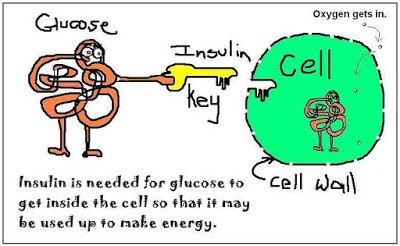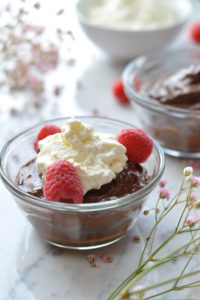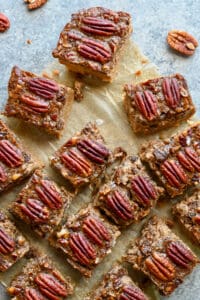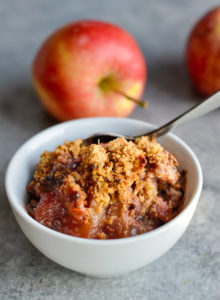Keep Your Blood Sugar Balanced Even With Dessert
Recipe Key

As we approach the holiday season, blood sugar balance is a topic many of us want to understand and control. In this post I am going to give you a simple explanation on how blood sugar works. Then I’ll give you a few of my best tips for keeping your blood sugar in balance while enjoying sweets over the holiday (or anytime). I’ve included lots of recipes too!
Eating dessert can cause blood sugar spikes and drops making you crave more sugar and carbs. The highs and lows can make you irritable and tired, give you a headache or even dizziness.
But does that mean we can’t enjoy desserts over the holiday?
Not at all. Sweetness is one of the five “tastes” that make food taste great. When we eat food with all 5 tastes; sweet, bitter, salty, sour and umami, we enjoy our food more and feel satisfied.
Clients often come to me because they struggle with cravings for carbs and sugar.
The key is learning how to keep your blood sugar balanced.
I love sweets, many of us do! That’s okay, we are here to enjoy our wonderful life. If you follow the guidelines below you will be able to enjoy desserts and stay balanced.
We Need Carbohydrates
Carbohydrates are the body’s primary source of energy. They introduce sugar into the bloodstream. We need them for our body to function well. Our muscles, organs, brain, heart, and liver rely on sugar for their energy source. We genuinely need the carbs that breakdown into sugar to keep everything running smoothly.
The types of carbohydrates we eat, when we eat them, and what we eat them with determine how much sugar is introduced into the bloodstream. When too many carbs get into the bloodstream all at once we get out of balance.
Complex carbohydrates such as fruits, starchy vegetables, beans and whole grains will introduce sugar to the blood stream at a slower, more gradual rate.
If we eat simple carbs or sugar alone it gets into the bloodstream quickly. If we eat them with protein, healthy fat and/or fiber the rate of absorption is slowed down.
Insulin and Blood Sugar
 After eating carbohydrates our body produces a hormone called insulin. Insulin’s job is to clear the sugar from the blood stream. Insulin moves glucose from the blood into other parts of the body where it is used for energy. Insulin acts as the key which unlocks the cell to allow glucose to enter the cell and be used for energy
After eating carbohydrates our body produces a hormone called insulin. Insulin’s job is to clear the sugar from the blood stream. Insulin moves glucose from the blood into other parts of the body where it is used for energy. Insulin acts as the key which unlocks the cell to allow glucose to enter the cell and be used for energy
Insulin also determines if our body is going to use the glucose now or store it for later use. If there’s too much glucose in your bloodstream, insulin says, “all the rooms are full, the doors are locked please bring some to the liver, so your body stores that excess glucose in the liver for later use.
Blood Sugar Spikes & Crashes
When you eat something that has a lot of sugar in it, like a cookie, your blood sugar levels quickly go up. The higher your blood sugar levels go, the more insulin your pancreas releases. When a rush of insulin goes into your blood, it quickly carries the sugar out and, as a result, your blood sugar level drops dramatically, sometimes to the point of low blood sugar This is very stressful for your body, causing the symptoms mentioned above.
When you get a blood sugar spike and then crash, it’s because there is a surge of insulin transporting the excess sugar out of your bloodstream very quickly. As your blood sugar drops quickly you crave chocolate or cake to restore balance. Then when you eat it, your blood sugar shoots right back up.
Over time, this can lead to a constant rollercoaster of spikes and drops, which is hard on your body.
How to Maintain Blood Sugar Balance
Our goal is to maintain blood sugar balance, not having excess blood sugar which causes spikes (highs) or excess insulin which causes drops (lows). We can do this with food and lifestyle choices that prevent highs and lows. Balanced blood sugar keeps us feeling our best.
1. Include Healthy Fats
 Eating healthy fats along with the carbohydrates or sugars slows down the rate of absorption. Since fats take longer to digest than carbs, they prevent blood sugar spikes and drops.
Eating healthy fats along with the carbohydrates or sugars slows down the rate of absorption. Since fats take longer to digest than carbs, they prevent blood sugar spikes and drops.
I recommend eating healthy fats like nuts, seeds, avocado, olive oil, coconut oil or ghee when you eat starchy carbs or desserts.
Recipe: Raw Chocolate Mousse
2. Eat Lots of Fiber
 Fiber, like healthy fats, slows down the rate of glucose absorption. Eating a diet with lots of vegetables, fruits, nuts, and seeds, especially chia and flax provides plenty of fiber.
Fiber, like healthy fats, slows down the rate of glucose absorption. Eating a diet with lots of vegetables, fruits, nuts, and seeds, especially chia and flax provides plenty of fiber.
If you like counting, aim for 30-50 grams of fiber a day depending on your digestive system. Read my article Fiber:The Magical Nutrient
Recipe: Pumpkin Chia Pudding
3. Eat Plenty of Protein
 Include protein with your meals to slow down the rate of carbohydrate absorption. Studies show including protein in your meals helps curb cravings by increasing levels of dopamine, the brain’s reward hormone. Protein also makes you feel full.
Include protein with your meals to slow down the rate of carbohydrate absorption. Studies show including protein in your meals helps curb cravings by increasing levels of dopamine, the brain’s reward hormone. Protein also makes you feel full.
Choose plant-based proteins like beans, lentils, nuts, tempeh, tofu or lean animal-based protein like pastured chicken, eggs or turkey, sustainable fish, grass-fed meats. Choose hormone free, certified humanly raised animal products.
Recipe: Garlic Lemon Chicken with Cauliflower and Anchovies
4. Reduce Stress
Stress releases cortisol into your bloodstream so you can “fight or flee.” Sugar is dumped into your bloodstream to give you energy. This is beneficial for short term stress when you need the energy. But when stress is prolonged or chronic, glucose can constantly be released from the liver resulting in long term high blood sugar.
Sugar cravings increase under stress. Then when you eat more sugar, you have imbalanced blood sugar levels leading to more stress and more cravings.
Find a few tools you like to help reduce stress. You can try some of these stress reducing strategies:
A Breathing Process from Dr Andrew Weil
Tapping Script for Stress Relief
5. Enjoy Your Food
Studies show what you think about what you eat affects your metabolism and hormones.
When you’re eating that piece of pumpkin pie at Thanksgiving and feeling guilty, thinking it’s going to make you fat, your body won’t be able to metabolize it causing a blood sugar spike. You won’t feel satisfied. But, if you’re loving it, enjoying every bite with appreciation you’ll boost your metabolism which will help stabilize your blood sugar levels.
Watch Dr. Alia Crum’s TED Talk of the Milkshake Study at Yale showing scientific proof our thoughts affect our metabolism. The hormone and metabolism study starts at 8 minutes.
This may sound very “woo,woo” but it makes a huge difference to your body. Bruce Lipton says in his book, The Biology of Belief: Unleashing the Power of Consciousness, Matter and Miracles “Our beliefs control our bodies, our minds, and thus our lives…”
It’s also fun to enjoy what you’re eating. As you notice the delicious tastes, textures, and smells of your dessert, you’ll feel more satisfied. Appreciating your food makes it easier to eat in moderation.
6. Sleep Well
 Lack of good sleep has been shown to increase blood sugar levels. Also, when you’re tired, you eat more, especially carbs, because you want to get more energy.
Lack of good sleep has been shown to increase blood sugar levels. Also, when you’re tired, you eat more, especially carbs, because you want to get more energy.
Make sleep a priority in your life. It’s one of the keys to balanced blood sugar and good health. Here are a few tips to help you sleep better.
7 Natural Sleep Remedies for Your Body Mind and Spirit
7. Choose Natural Unrefined Sweeteners
Since it not realistic or desirable to eliminate sweets, choose healthier options. Great desserts don’t have to be made with white sugar or white flour. Here are a few of my favorite natural sweeteners. These are better options than sugar but should still be enjoyed in moderation and with protein, fats, fiber and appreciation.
 Coconut Sugar – This granulated sugar looks like brown sugar but is made from the sap of the coconut palm tree. It has a lower glycemic index (35) than white sugar (60 to 65), meaning it doesn’t spike your blood glucose and insulin as much. It also contains potassium, magnesium, and sodium, which are all essential for regulating your body’s water content as well as many heart, nerve, and muscle functions.
Coconut Sugar – This granulated sugar looks like brown sugar but is made from the sap of the coconut palm tree. It has a lower glycemic index (35) than white sugar (60 to 65), meaning it doesn’t spike your blood glucose and insulin as much. It also contains potassium, magnesium, and sodium, which are all essential for regulating your body’s water content as well as many heart, nerve, and muscle functions.
Recipe: The Best Paleo Pecan Pie Squares (Dairy-Free, Gluten-Free)
 Raw Honey – Many types of honey particularly the raw, darker varieties, are a rich source of flavonoids which have antibacterial, anti-viral, anti-inflammatory and anti-allergenic properties. It is also a source of antioxidants. Honey has a lower GI than sugar (35-55). Buy local raw honey to get help with allergies. (1) Never feed honey to infants.
Raw Honey – Many types of honey particularly the raw, darker varieties, are a rich source of flavonoids which have antibacterial, anti-viral, anti-inflammatory and anti-allergenic properties. It is also a source of antioxidants. Honey has a lower GI than sugar (35-55). Buy local raw honey to get help with allergies. (1) Never feed honey to infants.
Recipe: Fresh Lemon Bars (Nut-Free, Paleo)
 Maple Syrup – Pure Organic Maple Syrup is full of antioxidants that are anti-inflammatory, and anti-bacterial. It contains calcium, iron, magnesium, potassium, zinc, copper, and manganese. These minerals support your immunity. It has a lower glycemic index (54) than cane sugar.
Maple Syrup – Pure Organic Maple Syrup is full of antioxidants that are anti-inflammatory, and anti-bacterial. It contains calcium, iron, magnesium, potassium, zinc, copper, and manganese. These minerals support your immunity. It has a lower glycemic index (54) than cane sugar.
Recipe: Apple Raspberry Cobbler (Nut-Free, AIP, Paleo, Vegan)
 Dates – Medjool dates have great health benefits and make great natural sweeteners. They decrease cholesterol and boost bone health. I often use them to make dessert crusts and energy bites.
Dates – Medjool dates have great health benefits and make great natural sweeteners. They decrease cholesterol and boost bone health. I often use them to make dessert crusts and energy bites.
Recipe: Bittersweet Chocolate Tart (Vegan, Paleo)
In conclusion: I hope this information helps you understand how you can keep your blood sugar stable and still enjoy holiday sweets. Remember to enjoy every bite. For blood sugar balance include protein, fat and fiber.
If you experience cravings or blood sugar highs and lows regularly and want some guidance to restore balance, email me at [email protected] to sign up for a free 15-minute Clarity session. We’ll talk about creating a healthy relationship with food and your body. I’ll show you how to use your inner guidance to care for yourself with balanced meals and kind thoughts so you can feel you best.

that’s great, love it.
Thanks Simon, I’m glad you find this information useful. Enjoy healthy desserts and keep our blood sugar balanced is wonderful and fun!